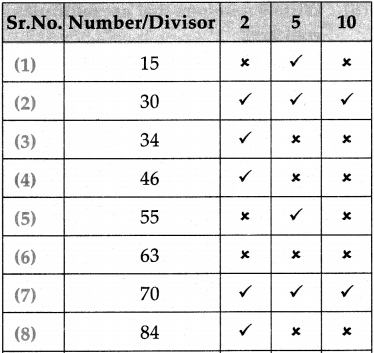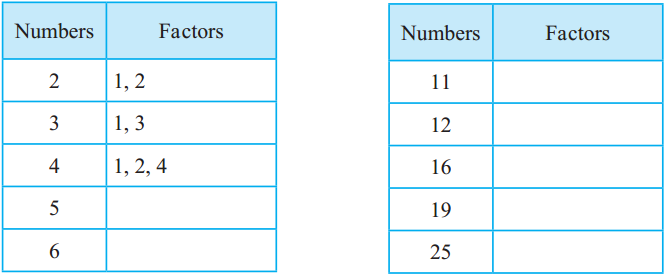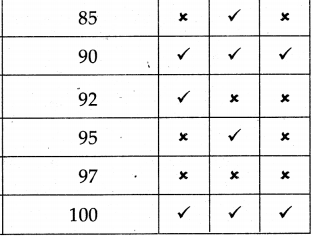Chapter 8 Multiples and Factors Problem Set 33 Textbook Exercise Important Questions and Answers.
Question 1.
(1) Write five three-digit numbers that are multiples of 2.
Answer:
100, 102, 104, 106, 108.
(2) Write five three-digit numbers that are multiples of 5.
Answer:
100, 105, 110, 115, 120.
(3) Write five three-digit numbers that are multiples of 10.
Answer:
100, 110, 120, 130, 140.
Question 2.
Write 5 numbers that are multiples of 2 as well as of 3.
Answer:
2 as well as of 3 means 2 and 3 that is multiples of 6.
They are 6, 12, 18, 24, 30.
Question 3.
A ribbon is 3 metres long. Can we cut it into 50 cm pieces and have nothing left over? Write the reason why or why not.
Answer:
3 metres = 300 cm.
We can cut it into 50 cm pieces.
Since 300 is exactly divisible 50.
That is 300 is multiples of 50.
300 ÷ 50 = 6
We will get 6 pieces, nothing is left over.
Question 4.
A ribbon is 3 metres long. I need 8 pieces of ribbon each 40 cm long. How many centimetres shorter is the ribbon than the length I need?
Answer:
1 piece of 40 cm, so for 8 pieces ribbon needed is 40 x 8 = 320 cm.
But ribbon is 3 metre = 300 cm long.
So ribbon is shorter by 320 – 300 = 20 cm.
Question 5.
If the number given in the table is divisible by the given divisor, put ✓ in the box. If it is not divisible by the divisor, put ✗ in the box.

Answer:

Prime and composite numbers
Some numbers are given in the tables below. Write all of their factors.

Dada : What do you notice on studying the table?
Ajay : The number 1 is a factor of every number. Some numbers have only 1 and the number itself as factors. For example, the only factors of 3 are 1 and 3. Similarly, the factors of 2 are only 1 and 2 and the factors of 19 are only 1 and 19. Some numbers have more than two factors.
Dada : Numbers like 2, 3, 19 which have only two factors are called prime numbers.
A number which has only two factors, 1 and the number itself, is called a prime number.
Ajay : What do we call numbers like 4, 6 and 16 which have more than two factors?
Dada : Numbers like 4, 6 and 16 are called composite numbers.
A number which has more than two factors is called a composite number.
Dada : Think carefully and tell me whether 1 is a prime or composite number.
Ajay : The number 1 has only one factor, 1 itself, so I can’t answer your question.
Dada : You’re right. 1 is considered neither a prime number nor a composite number.
1 is a number which is neither prime nor composite.![]()
Multiples and Factors Problem Set 33 Additional Important Questions and Answers
Question 1.
Write five three-digit numbers that are multiples of 3.
Answer:
102, 105, 108, 111, 114.
Question 2.
Write five two-digit numbers that are multiples of 7.
Answer:
14, 21, 28, 35, 42
Question 3.
Write five three-digit numbers that are multiples of 4.
Answer:
112, 116, 120, 124, 128.
Question 4.
Write 5 numbers that are multiples of 3 as well as 5.
Answer:
3 as well as 5 means 3 and 5. i.e. multiples of 15.
They are 15, 30, 45, 60, 75.![]()
Question 5.
A string is 4 metres long. Can we cut it into 50 cm pieces and have nothing left over?
Answer:
4 metres = 400 cm.
We can cut it into 50 cm pieces.
Since 400 is exactly divisible by 50.
That is 400 is multiple of 50 400 + 50 = 8
We will get 8 pieces. Nothing is left over.
Question 6.
A paper Is 2 metres long. I need 8 pieces of paper each 30 cm long. How many centimetres shorter is the paper than the length I need?
Answer:
A piece of 30 cm, so for 8 pieces paper needed is 30 x 8 = 240 cm.
But paper is 2 metre = 2 x 100 = 200 cm long.
So paper is shorter by 240 – 200 = 40 cm![]()
Question 7.
If the number given in the table is divisible by the given divisor, put P in the box. If it is not divisible by the divisor, put in the box.
Answer:

